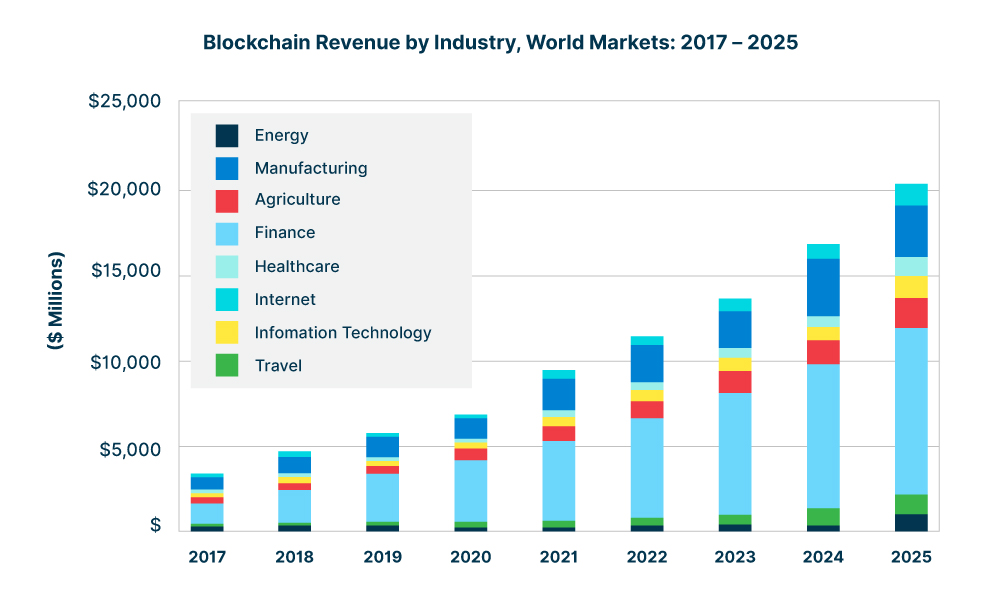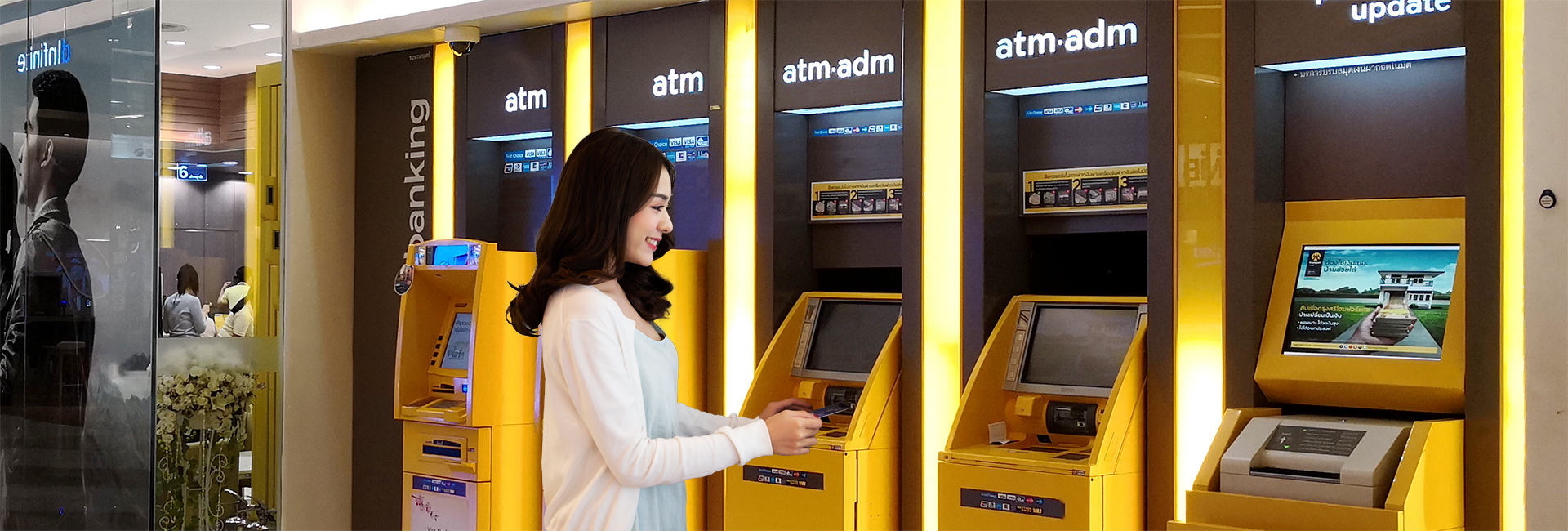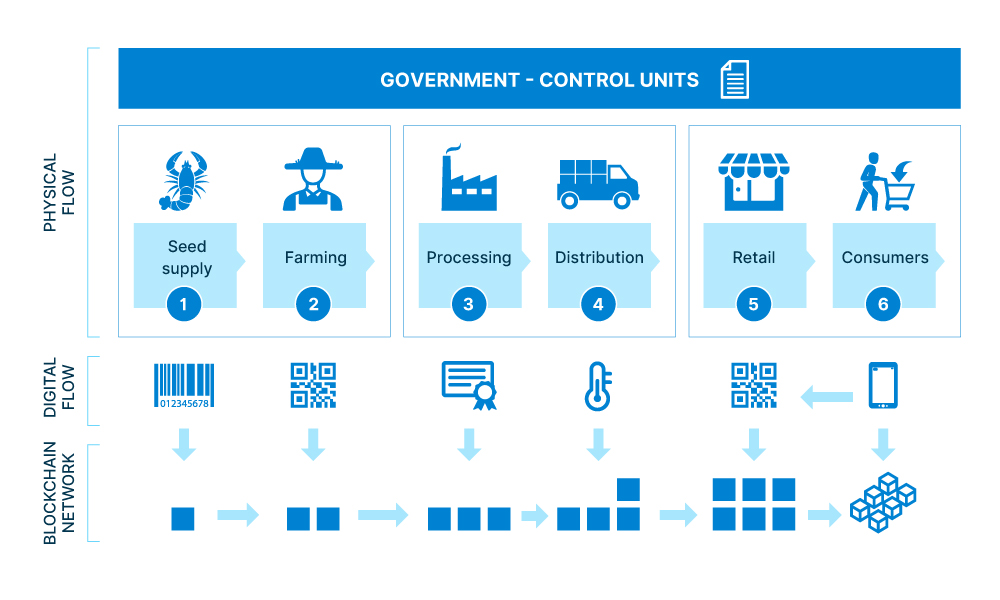Blockchain is currently researched and tested to trace and store transactions throughout the supply chain, helping to ensure food safety.
Consumers’ awareness of food safety issues is rising. Therefore, it is indispensable for manufacturers to give and verify detailed information of each chain in the supply process.

A study of blockchain revenue by industry from 2017 to 2025(1) shows that only after the financial industry is manufacturing industry at the second place with companies, especially food manufacturing companies are investing in this technology. Blockchain helps reduce the pressure of food safety regulations, policies and requirements for these businesses. In particular, traceability is considered as the key to solve these problems.
Many large enterprises are applying blockchain in traceability
Nestle and Carrefour – the world’s second-largest supermarket group have partnered in applying Blockchain to trace the origin of infant milk products in mid-2019. Emmanuel Delerm, the group’s senior manager, said that thanks to the adoption of blockchain, the number of Nestle dairy products sold at its supermarket chain has skyrocketed. After the deal with Nestle, the group also started to apply blockchain technology to 20 other agricultural products and plans to increase the number of traceable products to 100, focusing on products that safety is important such as baby food along with organic products.
Auchan, a French retail group, is also applying Blockchain technology to trace the origin of products in their supermarket chain. Initial testing which took place in Vietnam in tracing the origin of pigs, chickens and eggs in Ho Chi Minh City has brought impressive results. Currently, the platform is being deployed by Auchan in France, and in the future, in Spain, Portugal and Senegal.

What are the benefits of traceability with Blockchain?
Blockchain, which is in a distributed ledger form, helps solve a long-standing problem of businesses: TRUST. In short, it is a ledger that records transactions. This means that it includes all the data shared, authenticated and encrypted by the value chain participants. So, in terms of business, what are the benefits blockchain brings to manufacturers?
The nature of blockchain is to disclose all transactions in the network to help establish trust with consumers. This is the greatest value that manufacturers are looking forward. In a blockchain network, all members within the chain can see and validate information at any time.
Currently, consumers’ awareness of consuming food safety is increasing, especially in demanding markets such as the US, Europe and Japan. According to a research on food consumer behavior(2), 10 most important factors affecting consumers’ purchasing decisions are ranked as follows:

4 out of these 10 factors, including product’s freshness, safety, price of products and the seller’s assistance, depend largely on the manufacturer, the remaining factors depend on the sales unit. Using blockchain in traceability can help manufacturers solve 3 out of the 4 factors above.
1. Building competitive advantage by creating trust with consumers
By providing sufficient information about the chains in the supply process, manufacturers can give consumers a comprehensive view of the product’s origin, while ensure safety factors of the product.
Blockchain can track and trace the origin of the input process, this eliminates nearly 100% of the ability to fake products, better controls product quality while contributes to improving the overall value of the whole supply chain.
2. Minimize pressure on proving safe food
Blockchain also help manufacturers save costs and minimize the pressure in proving product origin. To ensure that it really works, the bank, its subsidiaries and related partners in the manufacturing process need to validate the information of all chain transactions.
3. Help manage production processes better in real time
With blockchain, manufacturers can manage the entire process starting from the farm until the goods hit shelves in real time. All information from farmers, caring process, distribution to storage, processing, etc. is recorded and monitored closely by the system. This helps manufacturers control the activities in the chain more effective and reduce the risk of unsafe food.
How does blockchain work in food traceability?
The food production process involves many elements in the chain such as farmers, transportation companies, distributors, processors, retailers, etc. Typically, the main stages of an Aquatic supply chain include:
1. Seed supply: including information on seeds, animal feeds, medicines, machines, etc. to transactions with farmers.
2. Farming: including information about farmers and the process of aquaculture as well as weather conditions, animal conditions, welfare regimes, etc.
3. Processing: including information about factories, equipment, processing methods, batch numbers, and financial transactions between processing units and distributors.
4. Distribution: including information on means of transportation, transport routes, storage conditions (temperature, humidity), transit time, and transactions between distributors and retailers.
5. Retail: information about each type of item, quantity, quality, expiry date, storage conditions and shelf time.
6. Consumption: This is the last step in the value chain, consumers can use the phone with internet connection to scan the QR code attached to the product to see all relevant information with Information from seed supply to retailers.

With Blockchain, this food supply process is made public for all participants within the chain, thereby minimizing frauds in operations and transactions and ensuring a transparent and safe economic environment for all stakeholders.
Reference sources
(1) Tratica. 2018. Blockchain for enterprises application.
(2) Cracow University of Economics. 2017. Consumer behaviour at the food market.




